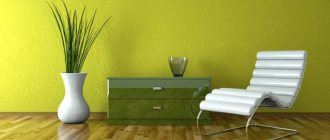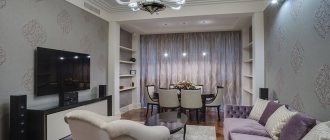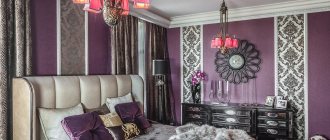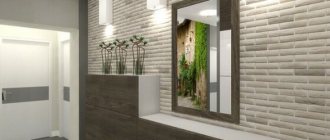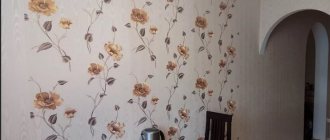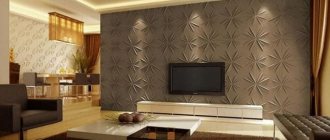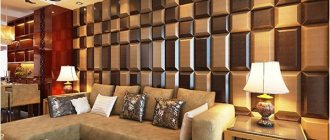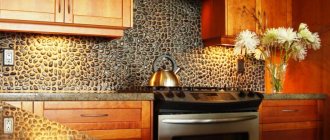Mosaic on the facade is an original and effective way to distinguish a building from the crowd. Examples of its use can be found everywhere and in any era: on churches and temples, on public and residential buildings, on landscape forms and installations. Mosaics on the facade can be of different colors and sizes. Fold into a pattern or cover the entire plane with one type of chip. In addition to its aesthetic qualities, the great advantage of this material is the ability to cover almost any shape without problems. Mosaic on the facade is a much more versatile finishing option than it might seem at first glance.
- What you need to know about mosaic finishing
- Characteristics and purpose of mosaics for the facade
- Types of mosaics for glass facades
- Ceramic and porcelain stoneware
- Stone
What is mosaic in design?
Mosaic in the interior is a type of coating, which is a material like small tiles, with which you can create simple compositions or original drawings, even picturesque panels. Previously, this type of finishing was considered art, and the parts themselves were called tesserae.
Mosaic tiles are universal: they can serve as the main covering and be floor, wall or ceiling, or can be used as decoration, enhancing a doorway, window sill, countertop, fireplace or some niche in the room. The facing side of the material can be glossy, matte or mixed, the color can be plain, with veins or original, the composition can be natural, mixed or synthetic (for example: mother of pearl, glass, ceramics, metal, etc.).
Mosaic on the floor in the guest bathroom
What style is it suitable for?
Mosaic is a universal decor and is suitable for many styles. It all depends on the color, texture and chosen pattern. The location of the mosaic element also plays an important role. Some trends are characterized by finishing only the walls, while for others this is unacceptable. Therefore, you should focus on the laws of the chosen style.
We will divide all proposed directions into two broad groups: historical and modern.
Trends of antiquity
Since mosaic was invented and gained popularity in ancient times, it is often used to recreate historical motifs. It is widely used in the Baroque and Rococo directions. At these times, this art was used mainly for flooring.
During the Gothic period, this type was widespread for finishing various surfaces. Along with stained glass, it was used within windows, on walls, and also on floors. This style is quite dark, characterized by sharp angles and straight lines, so choose dark matte tiles to recreate it.
The Victorian era is completely different and is reflected in the design accordingly. The style, which received the same name, is characterized by pomp and luxury in everything, from decoration to detail.
This direction is characterized by large images and large interior items, so large elements and corresponding patterns should also predominate in the design.
Mosaics were also widely known during the Renaissance. It was used everywhere here. The Renaissance period is considered one of the most beautiful, so colorful and positive motifs predominate in ornaments and designs. The direction is not devoid of brilliance and luxury, which is also reflected in the cladding.
Modern directions
Despite the fact that mosaic mainly emphasizes ancient trends, it is widely used in modern design. And with the advent of new materials and types, it has become quite popular nowadays.
- Perfect for the Mediterranean style trend. It has pronounced Greek motifs, so glossy and light tiles will only emphasize the advantages of the direction. In this case, mosaic tiles are used primarily for floor cladding. Artificial balconies and corresponding arrangement of bay windows are widespread here.
For these areas, this type of finishing is perfect. Speaking of colors: the Mediterranean style uses predominantly white, the whole spectrum of blue, light brown, and green.
- Provence is another style common in modern design. It is also called French country, so it is distinguished by tenderness and warmth. The hallmark of this trend is the beige color and rustic motifs in the design. In this case, the mosaic finish is used primarily in kitchen design. It is advisable to select models made from natural materials, light pastel colors and fine textures.
- stand apart . It has absorbed the trends of antiquity, and at the same time has undergone some changes in accordance with the present era. The use of the art described is also acceptable to her. But in this case it is necessary to emphasize rigor and conciseness. Classic has soft lines, but does not tolerate excesses. Choose simple patterns and soft colors to convey a classic feel.
Thus, if you decide to use mosaic in the interior of your apartment, first select a style, and then, acting in accordance with its laws, decide on the structure and type of tile.
In addition to full or partial finishing of walls or floors, you can use mosaic tiles to create interesting decorations that will become part of the design. Mosaic decoration of vases and boxes is still popular, and this technique is also used in creating original photo frames.
Types of interior mosaics
These products can boast of great diversity in terms of shape, texture, and scale, but most often the types of mosaics mean precisely the gradation according to the material of manufacture.
Popular types of mosaics:
1. Ceramic - one of the most common types of tiles, having different sizes and shapes; on the outside, tessera can be polished, rough, craquelure, with streaks, relief or imitation of some other material
Ceramic mosaic on the wall in the form of a panel in the master bathroom
2. Stone (artificial or natural) - marble, granite, onyx, slate, malachite - perhaps the most attractive and wear-resistant tile, which is always appropriate in both classic and modern home interiors.
Stone mosaic on the floor in the kitchen - zoning the dining room set
3. Glass (smalt) - smooth, matte, transparent or coated - whatever you like and with any shade; inlay will never be a losing option for it, because it presents itself as a fragile product that looks much more luxurious than ordinary glass accessories.
Light-colored glass mosaic in minimalist style
4. Mirror - has a peculiar shine, even if the coating is not entirely glossy; It is used mainly in modern styles, such as minimalism, fusion, functionalism, hi-tech, but is also suitable for a mixed direction such as eclecticism.
Mirror mosaic - decor on the wall in the dining room
5. Wooden - a relatively rare phenomenon in the houses of our time, but very beautiful and arousing delight, it resembles parquet, only from smaller parts, often square in shape (a chic option is a combination of several types of wood).
Wooden mosaic on the wall in the living room with a view
6. Non-standard - made from such expensive or exotic materials as shells, mother-of-pearl, jasper, amethyst, amber, lapis lazuli, silver, gold, platinum and many others, capable of striking on the spot due to its worthy composition and external expressiveness.
Custom-shaped mosaic made of natural stone on the wall
Look at the project : Apartment interior with “Imperial House” mosaic.
Briefly about the main thing
Mirror mosaic is a simple and budget-friendly way to improve your interior and give it an original look, regardless of style. In order for the decor to become the center of attention, it is necessary to choose it taking into account the pros and cons of the material, and also focus on the specifics of using the mosaic finish.
The most convenient for work is considered to be a mosaic mounted on a grid. Construction stores offer mirror decor, varied in color, shape and size of fragments. When choosing, pay attention to the nature of the edge processing, the presence of a protective coating and the size of individual parts. It is also important to correctly calculate the required amount of finishing.
Mirror mosaic decor has great design possibilities. It looks organically in the decoration of walls and ceilings, mirror frames and fireplace portals. Most often, mirror mosaics can be seen in the interior of the bathroom, living room and kitchen.
Ratings 0
Shape and size: always square or not?
Mosaic in residential or commercial interior design is a collection of a large number of small, large or different-sized fragments that can have a round, oval, square, rectangular, diamond-shaped, polygonal or other geometric shape. Quadrangular tesserae are more popular in use.
1. Square elements are most often laid out in even rows and columns, forming a strict classical ornament.
Black and white mosaic in the shower
2. Rectangular or diamond-shaped tesserae are a more non-standard option for decoration, although thanks to their clear lines they also look quite restrained.
Triangular floor mosaic made of natural stone
3. Round, oval and streamlined shapes will soften the interior, making it laconic, cozy and sophisticated.
Mosaic on the wall in a streamlined bathroom
4. Asymmetrical polygons and non-standard figured mosaics will allow you to realize bold creative ideas; Using unique combinations, you can easily create an intricate design or simply lay out the details in a random order.
Mosaic in the shower of a polygonal symmetrical shape
Tools and materials
If you approach finishing the facade with mosaics yourself, you will need the following tools and materials:
- notched spatula for applying glue;
- rubber or silicone spatula for grouting joints;
- special tongs for chipping tiles;
- thread for marking;
- putty;
- glue;
- grout;
- tile.
To decorate the facade with mosaics, you will need a notched trowel to apply glue.
Tesser color palette
The mosaic design has all sorts of color properties, ranging from a standard palette to acidic colors and metallic tints. Tesserae can be gold, mother-of-pearl, chameleons, with a mirror shine, with various inclusions, and even neon, depending on the lighting.
Bright tones of tiles are more often used in modern interiors, representing a fashion accessory rather than part of the decoration. Imitation of natural stones is more suitable for stylish classic options. Shades of silver and platinum are applicable for various directions, the main thing here is the artistic approach of the masters. Chandelier colors look especially expensive due to the fact that they change due to the amazing play of light and shadow.
Multi-colored glossy mosaic in the form of a panel in the bathroom
Choosing grout for sealing joints
There are two types of suitable mixtures for this purpose:
- Cement mastic. A cement-based mixture that is diluted with latex or water. The disadvantage of such mastics is their limited number of colors. In addition, cement mixtures are not able to withstand the negative effects of moisture and chemicals. Their advantage lies in their affordable cost, which is very important given the significant consumption of composition that occurs when working with mosaics. If you still prefer cement mastic, then it is better to choose one that is diluted with a latex plasticizer, since its level of resistance to moisture is noticeably higher.
- Epoxy grout. This material has very high technical performance. This grout withstands the effects of water, has a significant level of strength, withstands significant temperature changes and is not afraid of fungus.
Thanks to these qualities, its service life is very long. Epoxy grouts come in a variety of colors and are even transparent, so you can choose the right option for any type of mosaic tile. The main disadvantage of the material is its high cost.
Note! In some situations, epoxy grout is even used as an adhesive when laying regular or mosaic tiles, since it can be used to fix elements to any base.
What can be decorated with mosaics?
Tesserae are truly distinguished by their universal characteristics. Since they are able to cover not only large surfaces and serve as the main decoration, but also be an outlandish decoration of some separate part, which takes on the role of an accent. You can inlay arches, window openings, fillets, moldings, columns, corners, window sills, open shelves, niches, mirrors, fireplaces and much more. other. Places decorated with mosaics always look magical in design projects, indicating an exclusive approach to design.
Mosaic decor around doorways in the bedroom
Advantages and disadvantages
To make a decision about using mosaics as decoration, it is important to understand the costs of arrangement. This interior solution is practical and durable, but its implementation requires considerable costs. The cost of mosaics is determined by the naturalness of the material, its quality and quantity, and special coating. If you do the mosaic installation yourself, it will help you save money, but it will take time. If you hire specialists, mosaic finishing will be expensive.
Related article: Budget bathroom renovation: photo examples
But there are also economical ways to decorate with mosaics. It is possible to tile and use mosaics for individual inserts. This way, you can make an accent and highlight some areas in the interior, adding a little personality.
Like any material, mosaic has its disadvantages. The material is quite expensive, especially from reputable manufacturers. Material made in an unknown place will also suit few people. Installation by a good specialist is also expensive. If we are talking about a small surface, then even without experience in repair work, you can do it yourself if you wish. A lot of experience will be required when finishing large surfaces; not every specialist will cope with the task efficiently. Of course, the cost of the work will be significantly higher than when laying conventional tiles.
Methods for laying mosaics
Mosaics in an apartment or house are laid as an accent in various ways, resulting in:
1. Geometric shapes - more relevant for classics or minimalism; create strict or almost strict symmetry with a repeating simple pattern (this method is also suitable for covering large areas).
Mosaic on the bathroom floor in the form of a geometric pattern
2. Patterned shapes - ideal for the eastern direction; ornate pictures with complex elements are laid out (may resemble arabesques).
Mosaic in the hammam in the form of a repeating spiral pattern
3. Floral prints - suitable for ethnic, provincial, mixed styles; endow the situation with expressiveness and even some kind of primitiveness.
Mosaic in the bathroom with floral print
4. Fine panels are a beneficial solution for all areas of the interior; An animalistic, abstract or historical drawing always looks creative and unconventional.
Mosaic in a children's bathroom - panel with floral print
5. Three-dimensional images - for fashion trends in design; acts as the most unusual and at the same time simple way of design.
3D tiles on the bathroom floor
Recommendations from experts
The Japanese claim that every picture has a sound, has a subconscious “music”, and it should sound “solo”. Therefore, only one wall drawing is made in any room.
It is advisable that the large object is to the left of the observer - this makes the landscape seem lighter. Do not focus on seasonality, for example, snowflakes or autumn leaves.
Portrait images require strict adherence to proportions. Therefore, it is better to use a stencil of an enlarged design. Be sure to apply the initial markings so as not to violate the proportions.
For those who love floral images, it is better to make large objects. It is much easier to lay out sunflowers, lilies or fantasy flowers. It is more difficult to achieve a resemblance to living roses, daffodils or orchids, as in the photo of a mosaic made of broken tiles, made by the hands of a professional artist.
If it is an abstract or simple design, it is advisable to lay it from below, as when laying regular tiles. A heavy mortar with cladding will be better kept at a dry level from below. The tile adheres perfectly at room temperature – within +30°C. A panel of broken cement-based tiles dries completely in 2-3 days.
Mosaic in the apartment on various surfaces (photo):
On the wall
A mosaic wall can be monotonous or multi-colored, have a matte or glossy finish, have an extraordinary pattern, or be laid in even rows - it all depends on the chosen style and purpose of the room.
Mosaic on the wall in the bathroom of a non-standard shape
On the floor
When a mosaic is on the floor in an apartment, then the entire room as a whole is transformed. As a rule, it has some kind of strict geometric format; in more extravagant versions, it is made in the form of a painting with flowers, plants or birds.
Mosaic on the floor in the bathroom in the form of a geometric circular pattern
On the ceiling
Mosaic tiles on the ceiling are an extreme rarity: too painstaking a task for artists, but if they do end up over your head, they will give any decoration a truly individual design, and at the same time an excellent appearance.
Mosaic on the ceiling under the dome in the staircase
Features of mosaic works
When laying mosaics on the facade, you should pay attention to the following features:
- If ceramic or glass mosaics are applied to thin, poorly insulated walls, condensation will begin to form on the back of the cladding. Freezing and thawing, moisture will destroy the finishing layer. Under such conditions, mosaics on building facades will not last long. If you are not confident in the thermal insulation of the walls, it is better to work on it before facing work.
- To reliably protect the mosaic seams on the facade from the effects of precipitation, it is better to add a plasticizer to the grout.
- Pay attention to the expansion of the adhesive solution due to temperature changes. If it is too large, it will quickly destroy the mosaic cladding on the facade. To avoid this effect, choose materials only for outdoor use and use metal mesh covering.
Mosaic panels as a separate form of art
Interiors with mosaics in the form of panels deserve close attention, because they were created not only with the help of finished products and the skill of the designers, but also with the great effort of real creators who spent a lot of time creating a unique picture, not much different from other types of fine art. Thus, the resulting sketch in the room becomes not just part of the decoration, but is completely integrated into the design project, turning on the one hand into an aesthetic accent of the room, on the other hand emphasizing its attractiveness, expressiveness and self-sufficiency.
Look at the project : Apartment interior with mosaic “Moscow City”.
Fashionable mosaic panels often have images:
1. Flora - various indoor and wild plants, flowers or trees.
Mosaic in the form of a panel with a floral print in pastel colors
Mosaic in the form of panels on the wall and floor in the bathroom in pink tones
Mosaic panel with a large black and white flower on the wall in the bathroom
Mosaic panel with yellow flowers in the bathroom
Mosaic in the form of a panel with flowers on the floor in the bathroom
2. Birds - beautiful songbirds or other gorgeous wildlife.
Mosaic in the bathroom in the form of a panel with birds
Mosaic panel in the bathroom with an image of songbirds
3. Butterflies are magical fluttering insects with colorful colors.
Mosaic in the interior - a picturesque panel with butterflies on the wall
Mosaic in the interior - a panel on the floor with a butterfly
4. Of a person - full-length portrait or graphic drawings.
Office with a mosaic portrait of a man
Mosaic in the bathroom - a panel with a naked woman's body
Mosaic panel depicting the figure of a woman
Mosaic panel with a drawing of a naked woman in the bathroom
5. Cities - as seen from the height of some other building or simply an urban landscape.
Mosaic panel in the bathroom depicting New York
Mosaic in the bathroom in the form of a city landscape - view of the metropolis
6. Landscape - nature with its extraordinary naturalism and unpredictability.
Mosaic in the bathroom in the form of a painting depicting balloons and nature
7. Abstraction - something non-standard and challenging, but very original.
Mosaic panel in the bathroom with a multi-colored painting - abstraction
Preparing the base
Preparing the base begins with cleaning it. If there is old coating on the facade of the building, including plaster or paint, all this will need to be removed to the base. Dirt and dust are also removed. Then you need to inspect the surface for defects - depressions or cracks. Even minor damage needs to be repaired with a solution. After eliminating the defects, the base is leveled. The wall is covered with an even layer of primer. After it dries, for perfect smoothness the surface should be rubbed with a polyurethane trowel.
Examples of exclusive works: mosaics on the wall and floor in wet rooms (photo):
In the bathrooms
Mirror mosaic inserts in the bathroom
Mosaic border in the bathroom
Mosaic floor in strict black and white geometry in the bathroom
A panel with a floral print made of mosaic in the bathroom
White mosaic without a pattern in the shower
Mosaic in the interior - a picturesque panel with butterflies on the wall
In the hammams
Mosaic in the hammam with a painting - panel on the wall
Mother of pearl mosaic on the wall in the hammam
Pink shiny mosaic on the wall in the hammam
White mosaic on the floor in the hammam
In the swimming pools
Mosaic in the outdoor pool
Mosaic in a small pool of a country house
Mosaic in a large indoor pool in a mansion
Glue selection
For each type of mosaic, a suitable mixture is released onto the market. The choice of the right glue largely influences the final result of the work performed, which is why special attention must also be paid to its selection. You need to buy an adhesive composition solely taking into account the base of the walls and the finishing material used.
Ceramic tile adhesive
For elements made of ceramics, it is optimal to use any adhesive mixture that is made on the basis of gray or white cement. It is its color that determines the shade of the finished composition. To prepare such glue, you only need to mix the dry mixture with water or liquid latex.
The types of bases on which the tiles are glued play an important role. Taking into account their characteristics, three types of these compositions are manufactured: rigid, elastic and deformable. If you have to lay the material on concrete and plastered surfaces, cement screed or walls made of brick, aerated concrete and foam concrete, then you can resort to using any mixture intended for tiles.
If you need to lay the elements on waterproofing, old tiles or a heated floor system, then a more suitable option is to use elastic glue.
Glass tile adhesive
Due to the fact that smalt products have a transparent or translucent structure and the surface and shade of the adhesive composition through which gluing to surfaces is very clearly visible, in this case experts advise using mixtures of exceptional white color. Separately, you can note elements that do not have transparency. You can use gray glue for them.
Stone tile adhesive
Some types of stone can change their color due to prolonged exposure to water. Taking this into account, when laying stone mosaic tiles made from natural materials, it is better to use quick-hardening cement-based adhesive. In addition, a reactive polyurethane adhesive composition is a suitable option.
Adhesive for surfaces regularly in contact with water
If the walls are covered with mosaic tiles in a pool or shower, where the material constantly comes into contact with water, the selected adhesive mixture should have more impressive technical characteristics. Taking into account the fixation of cladding onto waterproofing in such cases, it is necessary to select compounds that have maximum resistance to moisture and elasticity. To increase the performance of the glue to the required level, it is additionally mixed with liquid latex. This is done in two ways:
- In the first case, the additive is first combined with water, after which it is poured into the cement mortar.
- In the second situation, exclusively liquid latex is used as the liquid when preparing the mixture. With this option, water is completely replaced by it in the solution and is not added.
Note! The assortment of construction stores also includes cement adhesive mixtures, which contain polymers that convert water into latex.
When gluing mosaic tiles with a mesh base in a pool or bathroom, you can use any elastic adhesive. By securing the elements with a mesh when cleaning the seams, the likelihood of products falling off is significantly reduced. Despite this, for pools it is recommended to choose a material with a paper backing, since only in this case is maximum contact between the mosaic tiles and the adhesive ensured.
Mosaic in living rooms using examples of modern design
Hallway
Mosaic on the floor in the hallway
Kitchen
Mosaic on the wall in the kitchen - apron
Dining room
Mosaic on the floor in the dining room
Bedroom
Decor in the form of a mosaic on the wall in the bedroom
Children's room for girls
Mosaic on the wall in a children's room for a girl
Children's room for a boy
Mosaic on the wall in a children's room for a boy
What should be the surface for laying
Before gluing the mosaic onto the surface, it needs to be prepared. It is advisable to perfectly level the base; the material stands out for its ability to fit on any uneven wall. But this will spoil the appearance of the result. Therefore, it is necessary to get rid of the flaws in the base.
It is also necessary to first clean the base from all types of contaminants and prime it. This will increase adhesion, and applying a starter putty will help get rid of dark spots on the substrate that can be visible under some types of mosaic.
It is advisable to perfectly level the base.
